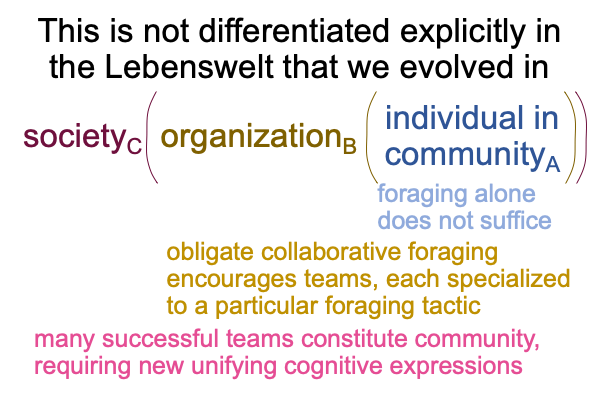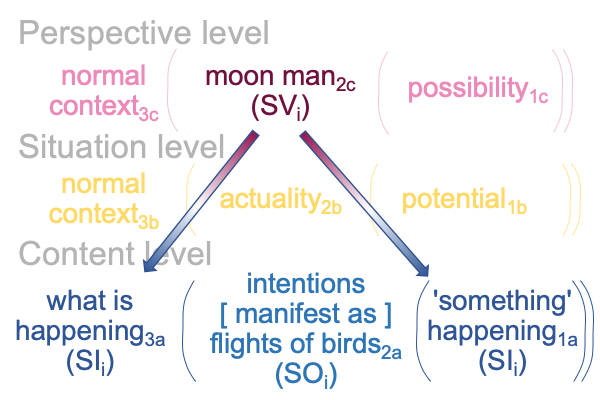0450 Chapter three asks, “What is the purpose of a corporation?”
Plus, when does a corporation become an institution?
I know the answer to the latter question.
A corporationaB becomes an institutionaC when it tries to put itself into perspective. A corporationaB has three levels: managementcaB, productionbaB and serviceaaB. An institution3aC has a mission-statement and a justification detailing the purposes2aC of the corporation. An institution also puts other corporations into perspective.
0451 At the risk of saying too much, I would like to wander into the territory of human evolution, in order to show that the distinction between corporation and institution is foundational.
Consider Razie Mah’s blogs for January through March, 2024, which covers some of the material in parts one and two of Comments on Michael Tomesello’s Arc of Inquiry (1999-2019) (by Razie Mah, available for purchase at smashwords and other e-book venues).
0452 Early on, in the Lebenswelt that we evolved in, our hominin ancestors adapt to Pliocene, then Pleistocene conditions, of mixed forest and savannah, by becoming bipedal. Bipedalism means that bands walk from one location of rich seasonal resources to another. Tomasello, a professor in evolutionary anthropology, claims that bipedalism potentiates a behavioral adaptation that he calls, “obligatory collaborative foraging”.
In short, long before the Homo genus appears in the fossil record, australopithecines are working in teams, communicating to one another with pantomime and pointing, and gathering more food than the team can eat in order to return to the band and share with friends and family. Each way of gathering or processing or storing food has its own team.
0453 No wonder the hominin brain expands over the course of time. Generation after generation, successful teams select for individuals capable of performing team-tasks and belonging to the team. Each team selects for adaptations that increase productivity as well as getting along and having fun. Such adaptations require neural networks that are primed to develop in response to exposure to team activities. The more successful teams, the bigger the hominin brain becomes.
0454 Today, in our current Lebenswelt, business start-ups are modern equivalents to teams. The goals are clear and specific, the tasks are both technical and collaborative. Team behaviors are readily diagrammed as sensible constructions, interscopes consisting in content and situation levels. Teams work to get sensible things done.
0455 Ramaswamy creates a start-up that grows into a corporation. He notes that the character of the institution changes. Typically, a team consists of 15 members and a community incorporates 150 members. That means that a community is just about a team of teams.
A community can flourish on sensible construction, to a certain extent. But, one may ask, “How do diverse teams work together as a ‘team’, when each team has a different way of foraging, complete with its own version of hand talk, and its own sense of humor?” Oops, I just slipped back into the Lebenswelt that we evolved in.
0456 But, the question still stands. A corporation is like a team of teams with each team devoted to a special function, ranging from research on biomolecular pathways in endometrial cells to keeping the facilities clean. Sensible construction goes only so far. The executive team with the vision for the start-up must engage in social construction. Social construction transcends sensible construction. Indeed, social construction creates the cognitive stage for the team of teams, the corporation.
0457 So, I ask, “Does the corporation contextualize itself as a team of teams using social construction?”
I answer myself, saying, “No, the moment that the team of teams puts itself into perspective, it must be labeled as an institution. The institution3aC‘s organizational objectives2aC are social constructions2aC. And, these social constructions2aC are built on declarations of righteousness1aC.
0458 Teams flourish on sensible construction. Corporations are teams of teams that rely on sensible construction, but sensible construction goes only so far, because corporations are also communities. The moment that a start-upaB grows into a community, itaB becomes an institution3aC, engaging in the social construction of organizational objectives2aC that actualize the potential of righteousness1aC.
0459 I summarize with the following diagram.

0460 This figure portrays a subtle point of contention behind Ramaswamy’s story about how sovereign legislation creates the legal space for limited-liability corporations.
Note the header.
The category-based nested form of three tiers is not differentiated in the Lebenswelt that we evolved in. As noted in The Human Niche, our ancestors evolve in social circles within a group that slowly increases in size over time. The waystations are family (5), intimate friends (5), teams (15), bands (50), community (150) and the resonances are mega-band (500) and tribe (1500).
0461 The individual cannot survive alone.
Two social circles play key roles and serve as sites for adaptations.
Teams organize in sensible ways. Proto-linguistic hand talk evolves in the milieu of teams. According to Tomasello, teams promote the evolution of second-person morality. I must care about other members of my team. We must be productive. We ought to have fun.
Communities institute themselves in social ways. Fully linguistic hand talk evolves after the domestication of fire, when teams become numerous, due to cooking and a new social venue that encourages talking outside of teams. Yes, I am talking about dinner.
Once hand talk is fully linguistic, hominins can make counter-intuitive, yet intrinsically sensible, statements. One can grammatically describe the moon man whose manual-brachial word gestures are seen in the flight of birds at night as well as the winds blowing across mountains. What is the moon man asking us to do?
Social construction is the meaning underlying the word, “religion”.
0462 Ramaswamy tells the story of the limited liability corporation in modern (or soon to be modern) Western civilization.
The LLC is like the team. Think sensible construction.
Then, the LLC is like a community. Think social construction.
0463 Of course, this legal fiction finds itself in a world where societyC, organizationB and individual in communityA are explicitly differentiated. Our current Lebenswelt is not the same as the Lebenswelt that we evolved in. So, the history of anything is complicated. Ramaswamy paints a portrait of historical legal innovations. My examination looks at the fabric of his canvas.
0464 But, I suspect that is not what the reader is thinking about.
The reader must be asking, “What about this moon man business?”
0465 Here is a picture.

0466 Everyone before the first singularity knows stories about the moon man.
[POINT to moon][Pantomime MAN]
